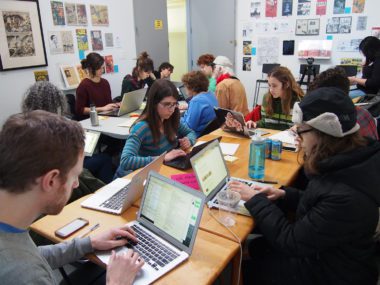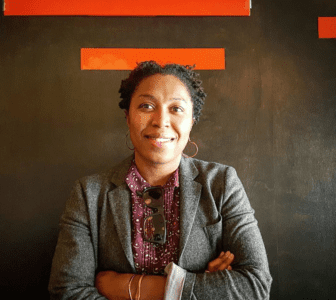
A feminist edit-a-thon at the Interference Archive, in Brooklyn. Photograph by RHODODENDRITES / Wikimedia Commons
Wikipedia is the 5th most popular website in the world. The page on COVID-19 is read often and updated by many people around the clock. It is important to acknowledge, however, that Wikipedia has fewer and less extensive pages and articles about women, or topics important to women, and other underrepresented groups. This reflects a critical absence in a widely visited site. To counter these biases, hosting edit-a-thons can be an engaging and supportive way for the community to participate in editing and adding Wikipedia entries on a variety of topics.
Usually held in person, edit-a-thons are community-organized events with the goal of encouraging and teaching people how to edit, add, or update articles on Wikipedia. However, with the pandemic, in-person activities are now transitioned remotely. In this interview, academic librarian Stacy R. Williams talks about her work and experience in organizing an edit-a-thon online.
Ray: Thanks for speaking with us! Tell us about your experiences transitioning to an online setting for a Wikipedia edit-a-thon program?
Stacy: Originally, I was apprehensive about moving the event to an online setting. Having attended Wikipedia edit-a-thons before, I thought that we would lose the collaborative and community-oriented energy of these types of events. We had planned for an in-person event with food, a facilitator, and a keynote. A student organization was going to have a photo booth and a button-making station outdoors as a way of encouraging additional participants to join the Wikipedia edit-a-thon.
Despite my hesitation, the move to an online setting was relatively smooth. We had to structure the format differently. Instead of having a facilitator, I gave an introduction to Wikipedia editing, and went over some basic rules to follow and important things to keep in mind when starting out. Although we still had a keynote speaker, we did not make time for actual editing. Instead, faculty and students gave lightning talks on the projects that they’ve worked on. The student group in the fall will hand out merchandise to participants who worked on a Wikipedia article either by editing one or adding a citation to one. Participants are encouraged to share what they’ve worked on by taking a screenshot and emailing the student group an example of what they did.
Ray: I’m glad you were able to launch the event remotely! What was something surprising you found?
Stacy: There were a lot more people who attended the online event than I was expecting. At one point, I looked at the number of attendees, and there were about 96 people in attendance. Folks were listening and using the chat feature to share information with one another or to ask questions.
Ray: Any tips you’d like to share for those who might have to do the same?
Stacy: I guess with all things, it’s important to be flexible and be willing to think outside of the box. It’s also harder to capture attention in an online environment—at least for me it is. People are at home and can be easily distracted, so try not to overwhelm with information—but make sure to have instructions and other guidance that you can share with them, in case anyone wants to follow up and learn more about what you’ve covered. Also, think about how you would like to assess what happened at the event—by talking to either co-organizers or participants afterwards about what went well or what could have been done differently.
 Stacy R. Williams is the Head of the Helen Topping Architecture and Fine Arts Library at the University of Southern California. She is the liaison for Architecture, Art History, Fine Arts, and Sports Studies. She received her B.A. in Social Sciences from New York University and her M.L.S. from Queens College, City University of New York. She is currently a student in the Master of Heritage Conservation program at USC’s School of Architecture. Her research interests include media/digital/visual literacy, digital scholarship in information literacy, and the process of creating, documenting, and preserving murals. When she is not in the library talking to students, she is spending time with and learning from her daughter, Stacy Jr.
Stacy R. Williams is the Head of the Helen Topping Architecture and Fine Arts Library at the University of Southern California. She is the liaison for Architecture, Art History, Fine Arts, and Sports Studies. She received her B.A. in Social Sciences from New York University and her M.L.S. from Queens College, City University of New York. She is currently a student in the Master of Heritage Conservation program at USC’s School of Architecture. Her research interests include media/digital/visual literacy, digital scholarship in information literacy, and the process of creating, documenting, and preserving murals. When she is not in the library talking to students, she is spending time with and learning from her daughter, Stacy Jr.


